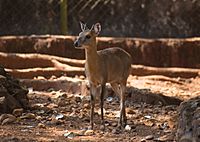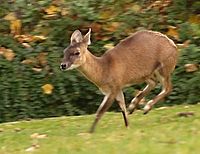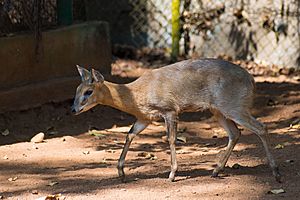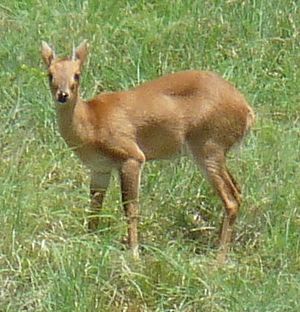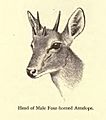Four-horned antelope facts for kids
Quick facts for kids Four-horned antelope |
|
|---|---|
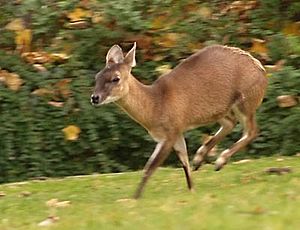 |
|
| Conservation status | |
| Scientific classification | |
| Kingdom: | |
| Class: | |
| Order: | |
| Family: | |
| Subfamily: | |
| Genus: |
Tetracerus
|
| Binomial name | |
| Tetracerus quadricornis |
|
The four-horned antelope (Tetracerus quadricornis) is a bovine even-toed ungulate. It is also called by its Hindi name chousingha. It is different from other bovines because it has four horns instead of two.
Four-horned antelopes are about 0.60 meters high, and they weigh about 20 kilograms. They have a light yellowish-brown fur with a white underside. They have a black stripe down their forelegs. Males have four horns. The back horns are about 10 centimeters long, and the front horns are up to 4 centimeters long.
Four-horned antelopes live in India and Nepal. They live in forests. Four-horned Antelopes live alone. They eat grass.
Four-horned antelopes are hunted by trophy-hunters because of their four horns, but they are also hunted for their meat. Because of the hunting and also because of habitat loss, there are now fewer than 100 four-horned antelopes.
Contents
Description
The four-horned antelope is one of the smallest Asian bovids. The number of its horns distinguishes it from most of the other bovids, that have two horns (sparing a few such as the Jacob sheep). The four-horned antelope stands 55–64 centimetres (22–25 in) at the shoulder and weighs 17–22 kilograms (37–49 lb); the head-and-body length is typically between 80 and 110 centimetres (31 and 43 in). Sexual dimorphism is not very notable, though only males possess horns.
Slender with thin legs and a short tail, the four-horned antelope has a yellowish brown to reddish coat. The underparts and the insides of the legs are white. Facial features include black markings on the muzzle and behind the ears. A black stripe marks the outer surface of each leg. Females have four teats far back on the abdomen. The hair feels coarse, more like that of a deer than the glossy hair typical of antelopes. The fetlocks are marked with white patches.
One pair of horns is located between the ears, and the other on the forehead. The posterior horns are always longer than the anterior horns, which might be mere fur-covered studs. While the posterior horns each measures 8–12 centimetres (3.1–4.7 in), the anterior ones measure 2–5 centimetres (0.79–1.97 in). Horns emerge at 10 to 14 months. According to Groves, anterior horns show the poorest development in the subspecies T. q. subquadricornutus. These horns measure nearly 4.5–5 centimetres (1.8–2.0 in) in T. q. quadricornis, and nearly 1.5–2.5 centimetres (0.59–0.98 in) in T. q. iodes. The posterior horn lengths for the subspecies recorded by him were: 8–10 centimetres (3.1–3.9 in) for T. q. quadricornis, 6.5–7.5 centimetres (2.6–3.0 in) in T. q. iodes and 1.8–2 centimetres (0.71–0.79 in) in T. q. subquadricornutus.
The four-horned antelope differs greatly from the nilgai in colour, is much smaller and has an extra pair of horns. The nilgai is nearly nine times heavier and two times taller than the four-horned antelope. Two deer species, the Indian muntjac and the hog deer, can be confused with this antelope. The four-horned antelope, however, lacks their antlers. The chinkara, a gazelle, can be told apart by its light brown coat and larger, ringed horns.
Ecology and behaviour
The four-horned antelope is diurnal (active mainly during the day), though it mainly rests or ruminates in dense undergrowth at noon. Though solitary by nature, the four-horned antelope may form loose groups of three to five. Groups consist of one or more adults, sometimes accompanied by juveniles. Males and females hardly interact, except in the mating season.
The antelope is shy and elusive. When alarmed, it stands motionless and may nervously leap away from the danger or even sprint. It often conceals itself in tall grasses to escape predators. The use of alarm calls to alert others is not common because the antelope tries to avoid the attention of predators. However, in extreme cases, these calls may be used to warn predators that they have been identified. Adults mark vegetation in their territories with a colourless secretion of preorbital glands, that soon condenses to form a white film. They maintain multiple latrine sites where piles of their pellet droppings are formed by regular use. Latrine sites can be confused with those of the barking deer but the pellets are longer and larger in four-horned antelopes. Submissive display consists of shrinking the body, lowering the head and pulling the ears back. Predators of four-horned antelopes include tigers, leopards, and dholes.
Diet
The four-horned antelope feeds on grasses, herbs, shrubs, foliage, flowers and fruits. A study in Mudumalai National Park (Tamil Nadu, India) showed that the antelope prefers grass species of the family Cyperaceae; genera Axonopus, Cynodon, Digitaria, Echinochloa, Panicum, Sehima and Sporobolus; and the species Imperata cylindrica, Ottochloa nodosa, Pseudanthistria umbellata and Themeda cymbaria. The shrub Grewia hirsuta is frequently eaten. Preferred herbs include Helichrysum, Indigofera and Tinospora species and Leucas aspera. The four-horned antelope feeds on the leaves of trees such as Cordia wallichii, Emblica officinalis, Randia dumetorum and Zizyphus xylopyrus. Grasses comprise nearly 29 percent of the diet, followed by foliage from trees (nearly nine percent). Grass and browse were consumed in nearly equal proportions. A study in the Panna National Park (Madhya Pradesh, India) showed preference for Zizyphus mauritiana, Acacia nilotica, A. leucophloea and A. catechu. Babool flowers were frequently eaten. The antelope often associates with langurs under fruiting trees, just as chital frequently do. Interaction with chital, a sympatric species, was infrequent. The antelope is wary when feeding, often raising its head and looking about its vicinity. The four-horned antelope needs to drink water frequently; as such it stays in places near water sources.
Reproduction
Breeding behaviour of the four-horned antelope has not been well studied. The age at which sexual maturity is gained is doubted; two captive females had their first parturition at less than two years. The breeding season in Panna National Park probably lasts from May to July, and from June to August in Mudumalai National Park. The male approaches the female in a relaxed gait, giving out low coughs. The two may kneel and push against each other with the necks intertwined. Gestation lasts about eight months, followed by the birth of one or two calves. The newborn has a head-and-body length of 42 to 46 centimetres (17 to 18 in), and weighs 0.7 to 1.1 kg (1.5 to 2.4 lb). Juveniles are kept concealed for the first few weeks of birth. Births in Mudumalai National Park peak from February to April. Juveniles remain with their mothers for about a year.
Habitat and distribution
The four-horned antelope inhabits areas with significant cover from grasses or heavy undergrowth, and close to water bodies. It generally keeps away from human-inhabited areas. Though they are habitat generalists, four-horned antelopes mostly occur in open, dry, deciduous forests in hilly terrain.
Earlier common throughout deciduous forests in India, four-horned antelopes are now found in low numbers. Their numbers were estimated at slightly above 10,000 in 2001, and are feared to be decreasing. In Mudumalai National Park, the populations are low and scattered. Their numbers in Gir National Park were estimated at 256 individuals in 1974; later estimates at waterholes in the same location put them a little above 1000. Densities of above 0.7 individuals per km2 have been considered as being healthy. Presently the four-horned antelope is confined to the Indian subcontinent, occurring widely in disjunct and small populations. The range in India covers a vast expanse, from the foothills of the Himalayas in the north to the Deccan Plateau in the south. Most of the existing populations are in India, and lower numbers in adjoining Nepal.
Threats and conservation
The four-horned antelope is threatened by the loss of its natural habitat due to agricultural expansion. Moreover, the unusual four-horned skull and the horns have been a popular target for trophy hunters. In India, the species is protected under Schedule I the Wildlife Protection Act of 1972 and the Nepalese population is listed in CITES Appendix III. The four-horned antelope is classified as Vulnerable by the International Union for the Conservation of Nature and Natural Resources (IUCN).
Major protected areas across India where four-horned antelopes occur include: Gir National Park (Gujarat); Bandhavgarh National Park, Bori Wildlife Sanctuary, Kanha National Park, Pachmarhi Biosphere Reserve, Panna Tiger Reserve, Pench Tiger Reserve, Sanjay National Park, Satpura National Park (Madhya Pradesh); Tadoba Andhari Reserve (Maharashtra); Kumbhalgarh Wildlife Sanctuary, Ranthambore National Park, Rangayyanadurga wildlife sanctuary (Karnataka), and Sariska Tiger Reserve (Rajasthan).
Images for kids
See also
 In Spanish: Antílope de cuatro cuernos para niños
In Spanish: Antílope de cuatro cuernos para niños



